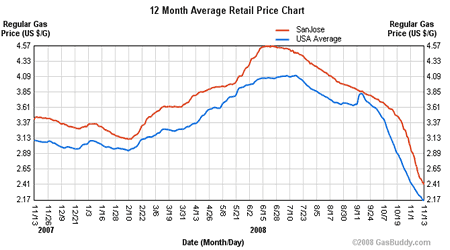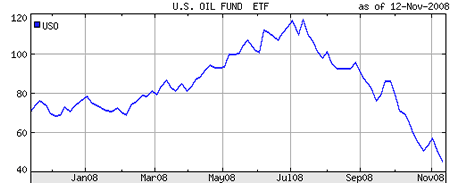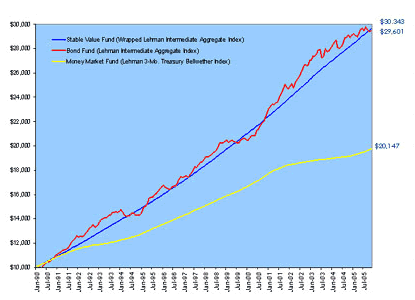I just filled up my tank for the least amount of money in a long time. When I first wrote about hedging against rising oil costs, the national average was $3.70/gal and headed towards $4/gal. Now it’s around $2.15. Remember when we were all afraid of $5 gas? Which got me thinking, perhaps now is a good time to reconsider hedging gas prices?
Example scenario: If you drive 12,000 miles per year and your car gets 25 MPG, that means an annual fuel bill of $1,920 with $4 gas. But with $2 gas, your annual bill is now only $960. Makes sense, a doubling of price from $2 to $4 again will lead to a doubling of cost – nearly $1,000 per year.
Now let’s say you buy $1,000 of one of the two major oil ETFs tracking crude oil prices, USO or OIL. (Use a broker with free trades.) If crude oil prices jump again, then the value of these stocks should roughly rise to compensate. If $4/gal comes back, your annual fuel bill would rise by $1,000, but your oil futures stock should also rise by $1,000. You’re virtually fully hedged this way, even if gas goes to $6/gal or higher.
So I suppose being fully hedged means buying as much oil ETF annually as you spend on gasoline in that time. Effectively, you are buying a year’s worth gasoline ahead of time and locking in that price. If gasoline wasn’t so difficult to store for long periods, you could do this manually.


Now, there is no free lunch here. If gas prices drop even further, then you won’t be able to benefit from cheaper gas either. A drop to $1 gas would leave you missing a savings of $500 per year, although I have a hard time seeing it drop that far.
Cost of hedging. Don’t forget, you could have invested that $1,000 somewhere else. If you assume an annual return of 8%, that’s a missed opportunity cost of $80 per year. Of course, we all know now that assuming stable 8% returns is not good. If it would have been held in a bank instead (a more likely scenario), then a 3.5% APY leads to an annual cost of $35, or $3/month.
Hedging is about having a price that you are comfortable paying, so that you don’t have to worry about unexpected price swings. Usually, it is also the case that you are more afraid of a potential rise than a potential drop. Gas prices have been one of the more volatile parts of our budget, and we could use this period of lower prices to build your hedge. Is it worth paying $3/month for such a hedge? I’ll let you decide.



 Coinstar is running a 2008 Holiday Promotion where you can turn $40 in loose change into $50 of Amazon.com gift certificates (or any gift certificate that they offer). Not a bad way to get rid of some change and pay for some holiday shopping. Selected fine print:
Coinstar is running a 2008 Holiday Promotion where you can turn $40 in loose change into $50 of Amazon.com gift certificates (or any gift certificate that they offer). Not a bad way to get rid of some change and pay for some holiday shopping. Selected fine print:

 Already started your own business, or thinking of doing so? Want to go “legit” and form an LLC or corporation? I received an heads up from about a promo next week Tuesday where you can get a free incorporation service worth $149:
Already started your own business, or thinking of doing so? Want to go “legit” and form an LLC or corporation? I received an heads up from about a promo next week Tuesday where you can get a free incorporation service worth $149:
 Discover Card is again running their Holiday Mall Promotion, which gives you $20 back for every $200 that you spend at limited mall locations.
Discover Card is again running their Holiday Mall Promotion, which gives you $20 back for every $200 that you spend at limited mall locations. The new fixed rate for Series I Savings Bonds (“I Bonds”) was
The new fixed rate for Series I Savings Bonds (“I Bonds”) was  Along with performing your civic duty today, you can pick up some free food from these locations. Some require an “I Voted” sticker, while others just take your word for it.
Along with performing your civic duty today, you can pick up some free food from these locations. Some require an “I Voted” sticker, while others just take your word for it.  The Best Credit Card Bonus Offers – March 2024
The Best Credit Card Bonus Offers – March 2024 Big List of Free Stocks from Brokerage Apps
Big List of Free Stocks from Brokerage Apps Best Interest Rates on Cash - March 2024
Best Interest Rates on Cash - March 2024 Free Credit Scores x 3 + Free Credit Monitoring
Free Credit Scores x 3 + Free Credit Monitoring Best No Fee 0% APR Balance Transfer Offers
Best No Fee 0% APR Balance Transfer Offers Little-Known Cellular Data Plans That Can Save Big Money
Little-Known Cellular Data Plans That Can Save Big Money How To Haggle Your Cable or Direct TV Bill
How To Haggle Your Cable or Direct TV Bill Big List of Free Consumer Data Reports (Credit, Rent, Work)
Big List of Free Consumer Data Reports (Credit, Rent, Work)